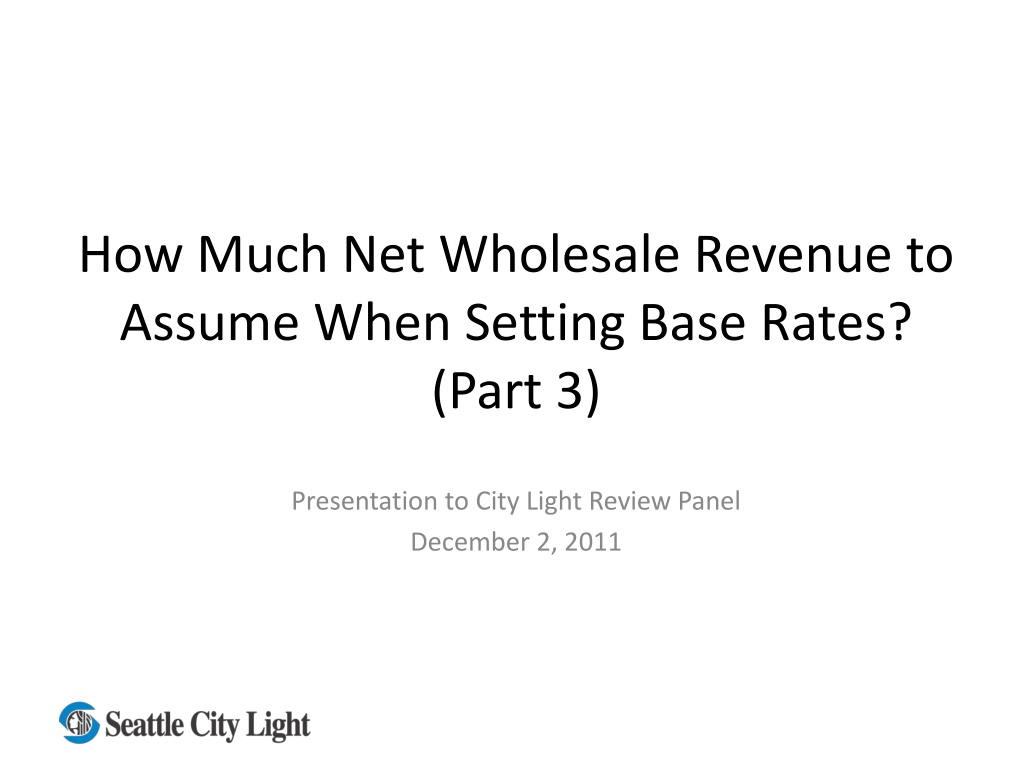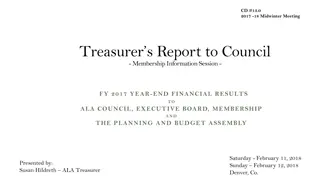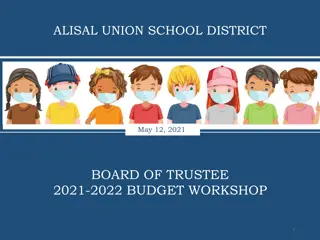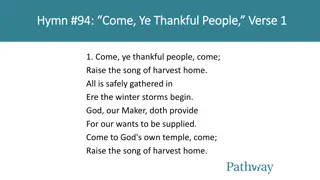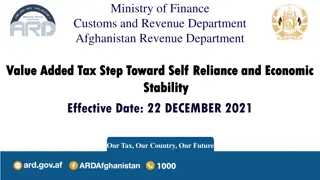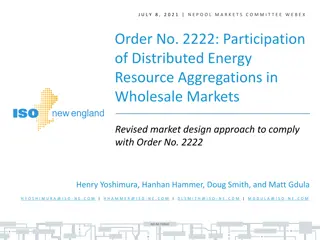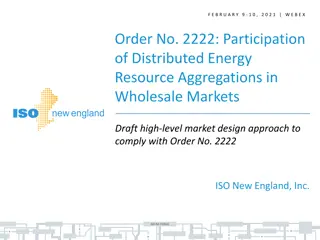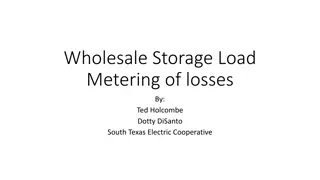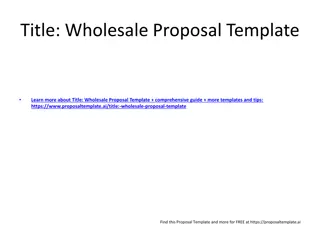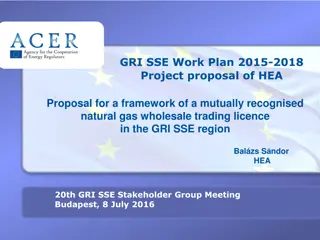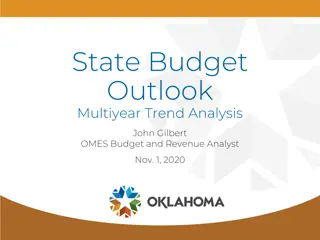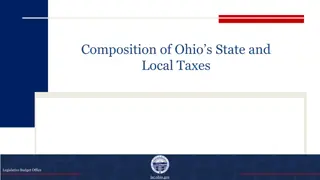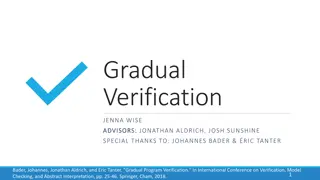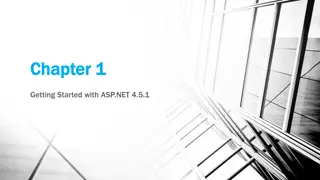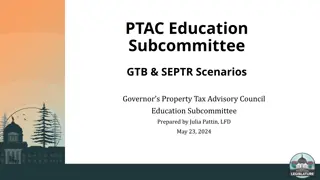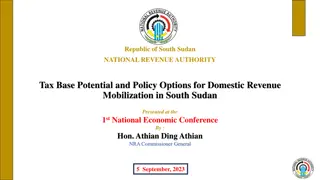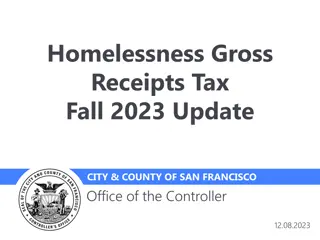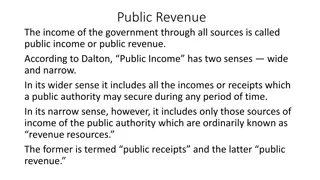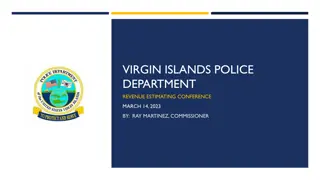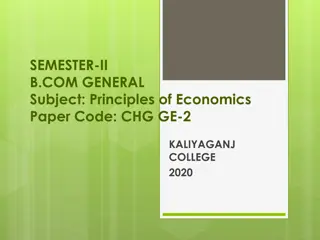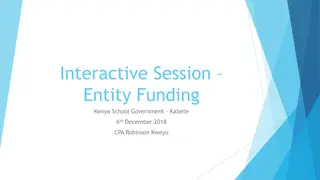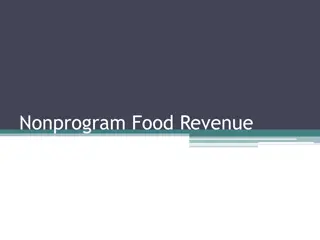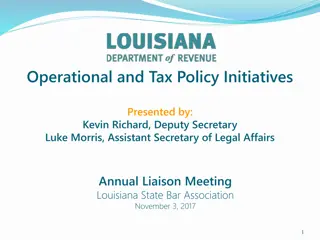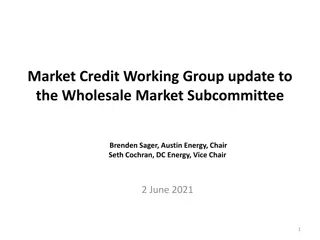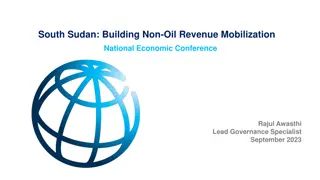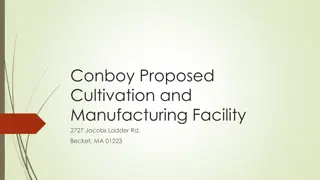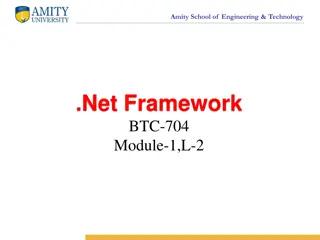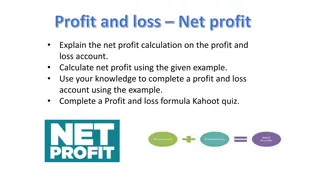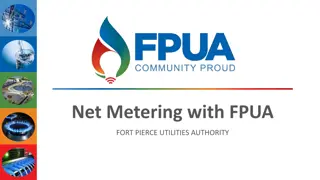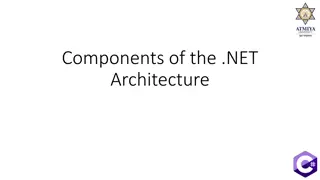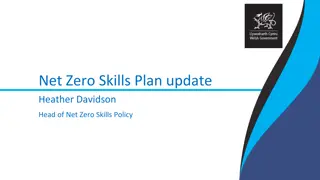Recommendations for Gradually Reducing Reliance on Net Wholesale Revenue
Historical data shows significant variability in net wholesale revenue, with the need to adjust assumptions for setting base rates. The presentation to the City Light Review Panel highlights potential rate surcharges due to overestimation of net wholesale revenue. To mitigate future surcharges, three solutions are proposed, with the recommendation being a gradual transition to a conservative estimate to reduce the likelihood of surcharges and provide refunds in surplus years.
Download Presentation

Please find below an Image/Link to download the presentation.
The content on the website is provided AS IS for your information and personal use only. It may not be sold, licensed, or shared on other websites without obtaining consent from the author. Download presentation by click this link. If you encounter any issues during the download, it is possible that the publisher has removed the file from their server.
E N D
Presentation Transcript
How Much Net Wholesale Revenue to Assume When Setting Base Rates? (Part 3) Presentation to City Light Review Panel December 2, 2011
Historical Net Wholesale Revenue (NWR) Revenue has been quite variable, ranging from $54-$140 million For any given year, NWR is affected by potential prices and volumes, producing a wide distribution of potential revenue outcomes 160 Actual NWR 140 120 100 80 60 40 EXPECTED 20 0 2002 2003 2004 2005 2006 2007 2008 2009 2010 2011 Draft-For Deliberative Purposes 2
Rate Surcharges Likely As Our NWR Estimate is Too High Rate Stabilization Account ordinance requires specifies how much net wholesale revenue to assume when setting rates. Amount is too high: Higher prices in past Doesn t reflect change in resource portfolio (BPA contract change) NWR likely to be below level Specified by RSA Ordinance: Ordinance Method: Avg Since 2002 Current Expected (normal water) Millions $120 $100 $80 $60 Consequences: Gap causes RSA to be drawn down RSA account falls below specified levels Higher potential for surcharges from 2012- $40 $20 $0 2012 2013 2014 2015 2016 2017 2018 3 Draft-For Deliberative Purposes
At Last Meeting, We Presented Three Potential Solutions to Reduce the Likelihood of Surcharges Option 1. Existing Method, with Adjustment for Change in Supply Portfolio 2. Move to Six Year Rolling Average, also adjusted Change in Supply Portfolio 3. Move to a conservative number (one we are likely to exceed 3 out of 4 years, or 75% exceedance ) over time, and reduce size of RSA to mitigate rate impacts along the way Draft-For Deliberative Purposes 4
We Recommend Option 3, Gradually Reducing Our Reliance on Net Wholesale Revenue When Setting Rates Avg Since 2002 Expected (normal water) Millions Gradual Move to 75% Exceedance $120 $100 3 of 4 chance that revenues will exceed this figure $80 Key Features Move to 75% exceedance while reducing size of RSA Account from $100M to $60M, cushioning impact of transition Significantly reduces the likelihood of surcharges, and will likely provide refunds in out years $60 $40 $20 $0 2012 2013 2014 2015 2016 2017 2018 Draft-For Deliberative Purposes 5
Rate Impact Summary Benefits: New RSA proposal has much lower expected surcharges, and credits are likely in the out years (and beyond 2018) Actual Bills when taking expected surcharges and credits into account are very similar during this period 2013-2018 AVG Line# 1 2 3 4 5 6 7 8 9 10 11 12 13 14 15 2012 2013 2014 2015 2016 2017 2018 Preferred Path with Current NWR Approach Typical Residential Bill (base rates) Annual Rate Increase $ 55.05 3.2% 56.91 $ 3.4% 60.39 $ 6.1% 64.46 $ 6.7% 67.41 $ 4.6% 70.43 $ 4.5% 72.69 $ 3.2% 4.7% 0.3% 55.21 3.2% 58.73 $ 6.4% 2.7% 62.03 $ 5.6% 1.8% 65.65 $ 5.8% 1.8% 68.66 $ 4.6% 1.5% 71.48 $ 4.1% 0.1% 72.79 $ 1.8% Expected RSA Surcharge Typical Res Bill (w/ surcharge) Annual Rate Increase (w/surcharge) $ $ 66.56 4.7% Preferred Path with Proposal NWR Approach Typical Residential Bill (base rates) Annual Rate Increase $ 55.05 3.2% 56.92 $ 3.4% 60.38 $ 6.1% 64.61 $ 7.0% 69.38 $ 7.4% 73.06 $ 5.3% 75.76 $ 3.7% 5.5% 2.0% 58.08 $ 5.5% 1.2% 61.12 $ 5.2% -0.15% 72.95 $ 5.1% -2.61% 73.79 $ 1.1% Expected RSA Surcharge/(Credit) Typical Res Bill (w/ surcharge/credit) Annual Rate Increase (w/surcharge/credit) $ 55.05 64.61 $ 5.7% 69.38 $ 7.4% $ 66.65 5.0%
Certain Aspects of the Rate Stabilization Account Would Be Changed: NWR assumed for setting rates gradually declines from $90M in 2013 to $64M by 2018 (the 75% exceedance number) Draw down RSA balance from $100M to $60M by 2016, using funds to mitigate rate impacts RSA Maximum Balance is $15M above RSA Target Balance (excess used to reduce rates in following year) RSA Surcharge Parameters: 1.5%, 3.0%, 4.5% surcharges applied at $10M increments below target balance in 2013-2014 and $6M increments in 2015-2018
Evaluation of Proposal Criteria Rate Transparency Achievement More difficult to compute, but more conservative Stability of Rates Year to Year Substantially eliminates likelihood of surcharges Very Good Very Good (probability of surcharges in 2018 reduced from 54% to 16%) Average Bills over the period Acceptable (essentially = to status quo) Base Rate Impact Acceptable Ability to Stay within Established 6 Year Rate Path Very Good Credit Rating Impact Neutral? Probability of RSA Balance falling below 0 Reduced versus current approach Draft-For Deliberative Purposes 8
Next Steps Further documentation and analysis in Financial Policy study Proposal included in Strategic Plan Develop ordinance for required changes to RSA, effective for 2013 Draft-For Deliberative Purposes 9
Appendix 11. Example Operation of the Revised RSA 12. Sensitivity Analysis 13. An Alternative to Further Mitigate Rate Impacts Draft-For Deliberative Purposes 10
The following example shows how the Rate Stabilization Account would operate during while moving to a more conservative NWR figure while reducing size of RSA Line# 1 2 3 4 5 6 7 8 9 10 11 12 13 14 15 16 17 18 2012 2013 2014 2015 2016 2017 2018 RSA Parameters City Light Expected NWR Proposed RSA NWR Target RSA Target Balance RSA Surcharge Trigger RSA Max 51.2 102.1 100.0 90.0 none 82.8 90.0 85.0 75.0 105.0 87.1 85.0 70.0 60.0 95.0 86.9 85.0 60.0 54.0 75.0 89.5 75.0 60.0 54.0 75.0 93.4 70.0 60.0 54.0 75.0 96.8 64.0 60.0 54.0 75.0 Example of RSA Beginning RSA Balance RSA Deviation Transfers RSA Surcharge Revenue, net of taxes Interest Earnings RSA Withdrawals Transfer of Funds over Max Ending RSA Balance 130.4 -50.9 80.6 -7.2 12.9 1.1 -15.0 0.0 72.3 72.3 2.1 8.2 1.4 -15.0 0.0 69.0 69.0 1.9 0.0 1.6 -10.0 0.0 62.6 62.6 14.5 0.0 2.0 0.0 -1.4 77.6 77.6 23.4 0.0 2.3 0.0 -25.1 78.3 78.3 32.8 0.0 2.3 0.0 -34.5 79.0 0.0 1.0 0.0 0.0 80.6 Expected Annual Average Surcharge Percent Expected Annual Average Credit Percent 2.0% 0.0% 1.2% 0.0% 0.0% 0.0% 0.0% 0.0% 0.0% 0.1% 0.0% 2.6% - Yellow highlighted numbers are the 75% exceedance numbers for those years - Blue highlighted numbers are RSA withdrawals used to mitigate base rates - Pink highlighted numbers: Surcharges and Credits shown above are expected values, actual values are very uncertain and will depend on actual NWR in current and preceding years Draft-For Deliberative Purposes 11
The Proposed Revision to the RSA Safeguards the Effectiveness of the Account Under Stress Conditions and Reduces the Likelihood of Surcharges Example of Persistently Adverse NWR: What if actual NWR turned out to be $50M every year? Ref 2013 2014 2015 2016 2017 2018 1 2 3 4 5 6 7 8 9 10 11 New Proposal Adverse NWR Scenario RSA Baseline, Net Wholesale Revenue Expected Ending RSA Balance Expected Annual Average RSA Surcharge 50.0 90.0 44.9 2.95% 50.0 85.0 25.7 4.50% 50.0 85.0 13.7 4.50% 50.0 75.0 24.6 4.50% 50.0 70.0 43.0 4.50% 50.0 64.0 52.2 2.52% Current Method Adverse NWR Scenario RSA Baseline, Net Wholesale Revenue Expected Ending RSA Balance Expected Annual Average RSA Surcharge 50.0 104.8 47.0 3.82% 50.0 100.6 27.3 4.50% 50.0 98.9 11.2 4.50% 50.0 97.7 (2.1) 4.50% 50.0 96.8 (13.1) 4.50% 50.0 96.4 (22.6) 4.50% Conclusion: With the proposed revision, the RSA is better able to handle consecutive low NWR years than the current method Monte Carlo Probability Analysis Results Proposed RSA Method Current RSA Method Probability of RSA balance going below $0 during 2016-2018 12% 14% Probability of a surcharge in 2018 27% 54% Draft-For Deliberative Purposes 12
To further mitigate rate impacts during 2013-18, the Utility could defer some bond principle repayments for issuances during this period 2013-2018 AVG Line# 1 2 3 4 5 6 7 8 9 10 11 12 13 14 15 16 2012 2013 2014 2015 2016 2017 2018 Preferred Path (without addressing Net Wholesale Revenue) Typical Residential Bill (base rates) Annual Rate Increase 55.05 $ 3.2% 56.91 $ 3.4% 60.39 $ 6.1% 64.46 $ 6.7% 67.41 $ 4.6% 70.43 $ 4.5% 72.69 $ 3.2% 4.7% 0.3% 55.21 $ 3.2% 58.73 $ 6.4% 2.7% 62.03 $ 5.6% 1.8% 65.65 $ 5.8% 1.8% 68.66 $ 4.6% 1.5% 71.48 $ 4.1% 0.1% 72.79 $ 1.8% Expected RSA Surcharge Typical Res Bill (w/ surcharge) Annual Rate Increase (w/surcharge) $ 66.56 4.7% Preferred Path Including NWR Fix, and Principal Deferrals Typical Residential Bill (base rates) Annual Rate Increase 55.05 $ 3.2% 56.92 $ 3.39% 60.38 $ 6.09% 63.52 $ 5.19% 66.72 $ 5.04% 70.20 $ 5.21% 73.84 $ 5.19% $ 65.26 5.0% 2.0% 58.08 $ 5.5% 1.2% 61.12 $ 5.2% -0.2% 70.06 $ 5.0% -2.7% 71.84 $ 2.6% Expected RSA Surcharge/(Credit) Typical Res Bill (w/ surcharge/credit) Annual Rate Increase (w/surcharge/credit) 55.05 $ 63.52 $ 3.9% 66.72 $ 5.0% $ 65.22 4.5% Principal Deferral Information Total Annual Principal Payment on New Debt Issues (2013-2018) Amount of Principal Repayment Deferred Remaining Principal Payment in this year Total 17 18 19 20 3.6 3.6 0.0 10.3 7.0 3.3 17.5 17.5 0.0 24.1 20.0 4.1 30.2 15.0 15.2 85.6 63.1 22.5 -Alternate shows rate benefit of deferring $63M of Principal Payments over this time period. Principal would be repaid in future years, without extending the 20 year life of each bond. -Debt to Capitalization would be app. 2% (59.5% vs. 57.4%) higher at year-end 2018 if the principle was deferred in this manner. -Could resume scheduled principle payments in 2018 (make full $30.2M payment), increasing rates in that year by 3.1% to 5.7% on a net basis, and the 6 year average increase to 5.1%.
